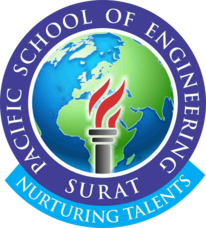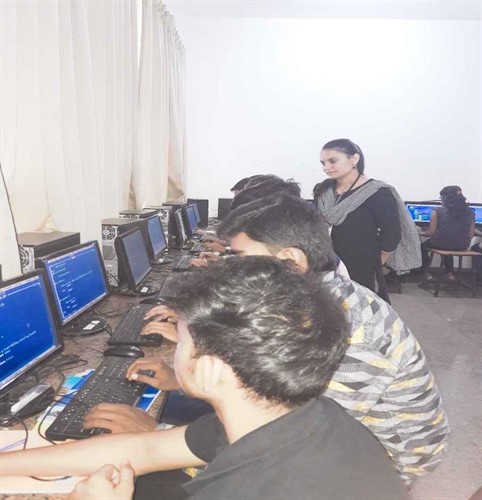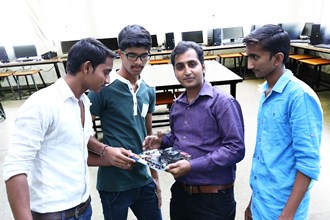
Pacific School of Engineering
Approved by AICTE,New Delhi and Affiliated to GTU,Ahmedabad
Integrated M.Sc. IT | Degree Engineering | Diploma Studies

Lab Description
AI (Artificial Intelligence) Lab: In an AI lab, students explore various techniques and algorithms used to create intelligent systems that can simulate human-like behavior. They learn about topics such as machine learning, neural networks, natural language processing, computer vision, and robotics.
IoT (Internet of Things) Lab: In an IoT lab, students learn about the design, implementation, and deployment of IoT systems that connect physical devices to the internet to collect and exchange data. They study concepts such as sensor networks, wireless communication protocols, embedded systems, and cloud integration.
Cloud Computing Lab: In a Cloud Computing lab, students explore the principles and technologies behind cloud computing, which involves delivering computing services over the internet. They learn about cloud infrastructure, virtualization, distributed systems, networking, and security in the cloud.
Python Lab: In a Python lab, students focus on learning the Python programming language, which is widely used for various purposes such as web development, data analysis, machine learning, and scripting. They learn about Python syntax, data types, control structures, functions, modules, and object-oriented programming.
|
Lab Name |
AI, IOT, Cloud Computing and Python Lab |
|
Configuration |
Intel® Core™ i5 RAM: 8.00GB SSD: 1TB OS:Windows 11 |
|
No. of Machines |
20 |

Lab Description
Java Programming Lab: In a Java Programming Lab, students learn and practice programming concepts using the Java programming language. They cover fundamental Java syntax, object-oriented programming principles, data types, control structures, and classes.
Web Programming Lab: In a Web Programming Lab, students learn about technologies and frameworks used for web development. They study HTML (HyperText Markup Language), CSS (Cascading Style Sheets), and JavaScript for building the structure, styling, and interactivity of web pages.
|
Lab Name |
Java and Web Programming Lab |
|
Configuration |
Intel® Core™ i5 RAM: 8.00GB HDD: 1TB OS:Windows 10
|
|
No. of Machines |
20 |

Lab Description
DBMS (Database Management Systems) Lab: In a DBMS lab, students typically work with software tools and systems used to manage databases. They learn about concepts such as creating and managing databases, designing schemas, querying data using SQL (Structured Query Language), and implementing database transactions.
DS (Data Structures) Lab:In a DS lab, students learn about fundamental data structures and algorithms used to organize and manipulate data efficiently. They study concepts such as arrays, linked lists, stacks, queues, trees, graphs, and hash tables.
ADA (Analysis and Design of Algorithms) Lab: In an ADA lab, students focus on the analysis and design of algorithms to solve computational problems efficiently. They study various algorithm design techniques such as divide and conquer, dynamic programming, greedy algorithms, and backtracking. Students implement algorithms in programming languages and analyze their time and space complexity.
|
Lab Name |
DBMS, DS and ADA Lab |
|
Configuration |
Acer/Veriton Series Intel(R) Core(TM) i3-4160 CPU@3.60 GHz RAM:4.00GB HDD:500GB OS: Windows 10 |
|
No. of PC |
20 |

Lab Description
PPS: A "Programming for Problem Solving" lab is designed to help students develop problem-solving skills using C programming.The lab begins with an introduction to various problem-solving techniques such as understanding the problem, breaking it down into smaller subproblems, devising algorithms, and designing efficient solutions.
OS: OS, or Operating Systems, are software programs that manage computer hardware and provide services for computer programs. The operating system acts as an intermediary between the hardware and the user applications, handling tasks such as process management, memory management, file system management, and device management.
CN: CN, or Computer Networks, is the study of how computers and other devices are interconnected to facilitate communication and resource sharing. Computer networks enable data transmission between devices, allowing users to access remote resources, share files, and communicate over long distances.
|
Lab Name |
PPS,OS and CN Lab |
|
Configuration |
Acer/Veriton Series Intel(R) Core(TM) i3-2120 CPU@3.30 GHz RAM: 4.00 GB HDD:500 GB OS: Windows 10/Ubuntu |
|
No. of PC |
20 |

Lab Description
Project Lab: A Project Lab is a practical learning environment where students work on hands-on projects to apply the knowledge and skills gained in their coursework. a Project Lab provides students with valuable hands-on experience, fosters teamwork and collaboration, and prepares them for real-world challenges in their respective fields of study or industry domains.
|
Lab Name |
Project Lab |
|
Configuration |
Intel® Core™ i5 RAM: 8.00GB HDD: 1TB OS:Windows 10 |
|
No. of Machines |
20 |


